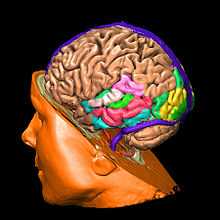Voxel-Man

Brain rendered with VOXEL-MAN from magnetic resonance imaging data 1998.
VOXEL-MAN is the name of a set of a computer programs for creation and visualization of three-dimensional digital models of the human body derived from cross-sectional images of Computer Tomography, Magnetic Resonance Tomography or photography (e. g. the Visible Human Project).[1] It was developed at the University Medical Center Hamburg-Eppendorf. Applications include digital anatomical atlases and surgery simulators. The name is derived from the term Voxel, the elementary cuboid component of a digital representation of a three-dimensional object ( a "threedimensional pixel"). Occasionally the name Voxel-Man is also used as a general term for a digital representation of the human body.
References
- ↑ Khan, S. A. (1998). "Voxel-Man Junior Interactive 3D Anatomy and Radiology in Virtual Reality Scenes, Part I: Brain and Skull". JAMA: The Journal of the American Medical Association 280 (8): 754–754. doi:10.1001/jama.280.8.754. Retrieved 6 December 2011.
The potential of the data set is enormous. If manipulated by a computer in an interactive way, it can represent an electronic cadaver that can be dissected infinite times in infinite ways. It can also make us go "inside" the human body and look at structures in ways that were never thought possible.